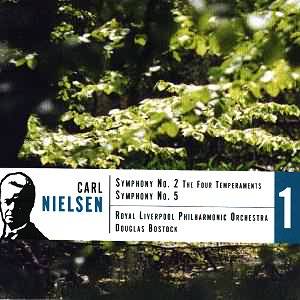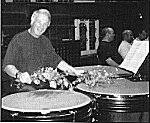
[See also comparative review with the new
recording conducted by
Michael
Schønwandt]
It is heartening to note that this release is marked as 'Volume 1' of the
Carl Nielsen Edition, something which is definitely an essential requirement
in our understanding of the complete definitive versions of these magnificent
symphonies. First of all, Classico's sound is astonishingly clear and vivid,
matching (if not surpassing) Herbert Blomstedt's Decca versions for powerful
intensity. We must always live with Grondahl and Jensen's pioneering versions
of these works (Danacord/Dutton) but Bostock is now the real modern alternative
not least for his option to use real 'sordino' sticks in the 'Four Temperaments'.
In this symphony, Bostock almost matches Jensen's unique 1948 account for
choleric intensity while the Andante malincolico is beautifully shaped with
some marvelous contributions from the RLPO strings. If not quite eclipsing
Jensen's account, Bostock's is definitely a clear front runner amongst modern
versions and the tweaks of this new CN edition are noticeable to Nieslen
afficionados.
With the Fifth we are on more exalted ground, indeed I will continue to state
my case (alongside Robert Layton and David Fanning) that this is one of (if
not 'the') the greatest symphonies of modern times. The striking ostinato
on the side drum, the magnificent hallowed beauty of the Adagio non troppo
and the exhaustive 'alert forces' of the final tour de force are incomparable
in Twentieth Century symphonic literature. Bostock's reading is once again
in the Jensen field (that magnificent 1954 Decca version), indeed his Tempo
giusto wavers little from the markings in that reading although the tidying
up of the CN edition is more evident here. Nicholas Cox's weaving clarinet
compares favourable to Ib Eriksson's whilst the eerie ostinato of Graham
John's side drum is also in the top field. The Adagio non troppo is also
beautifully alive with the big theme rising out of the ashes in almost
sphinx-like grandeur. The quickening up of the savage side drum towards the
end of the movement generates unbearable tension and as the glorious theme
returns, the sense of exultation and magnificence is almost orgasmic in its
hallowed intensity, this is indeed vintage Nielsen.
I am not that sufficiently qualified to analyze the awesome Finale which
is distinctly split into four movements, other experts like fanning and Layton
have done this before but I will just say that Bostock's quick tempo moves
the music along with greater intensity and momentum. The essential recordings
remain, Jensen (1954), Tuxen (1955, Paris) and Hoeberg (1933, wondrous although
far out), together with Blomstedt (1976/1985). Bostock's version joins this
exalted company and how! I await further releases in this series with bated
breath and keen anticipation, in the meantime this shattering Fifth will
keep me going till the end of the century!
Reviewer
Gerald Fenech

footnote
 In
bars 76-85 of the third movement of the Second symphony Nielsen asks for
a special sordino (a subdued or muffled sound) and
requests that a small fan-shaped brush of fine birch twigs be used
to create a rustling sound. I attended a live performance where, as on this
recording, these request was fully complied with to effect. Those twigs were
fully clothed in leaves; now that it is autumn and the leaves have fallen
I am sure the sordino would have a different sound texture.
In
bars 76-85 of the third movement of the Second symphony Nielsen asks for
a special sordino (a subdued or muffled sound) and
requests that a small fan-shaped brush of fine birch twigs be used
to create a rustling sound. I attended a live performance where, as on this
recording, these request was fully complied with to effect. Those twigs were
fully clothed in leaves; now that it is autumn and the leaves have fallen
I am sure the sordino would have a different sound texture.
Len Mullenger.

